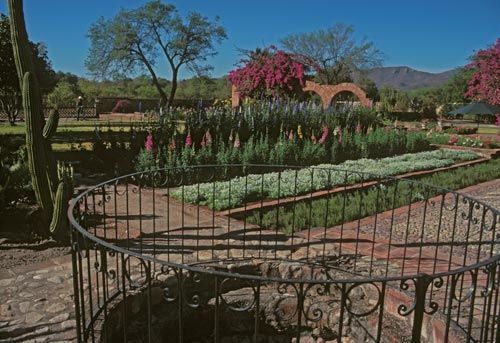Jacoby Gardens and Tequila
Last modified: March 31, 201877… A garden that fills the land with grace and majesty…
Anders remembers Judith Jacoby as a charming graceful petite woman. On
each side of her house were gardens taking advantage of what was there
before, or left behind, and drawing inspiration from the landscape
backdrops; Sierra de Álamos to the south, Cerro Cacharamba to the west,
the northern mountain ridges and a long formal drive way in from the town
to the east. I am sure she knew every inch of this land.
When I visited Mrs. Jacoby she was there by herself, a captain maintaining
a property that was her ship on the vast Sonoran way of life. She would
ask me what I knew, knowing that all I did was walk. look and listen with
cameras in hand. She would intently attend my interpretation of events,
rarely commenting other than a nod of her head or small smile. At the
time, she must have had the largest Alamos garden in acreage. Laid out on
what was once a tequila factory warehouse, the gardens, with wild lands on
the other side of tall walls, were always ready for presentation as if
today there was to be a party.
Knowing the human condition there is a good chance the original tequila
factory was successful. Men have long sought distilled drink for
company. And in the mining days of Álamos there was a large population of
hard working men, certainly there was a need for tequila. Questions rise:
how many gallons were produced yearly and when was the height of
production?… how far was it exported – did bottles make their way to San
Francisco, Mexico City or Europe?… what did the bottles look like?…
was all the agave grown locally?… how many workers were involved?… was
this a profitable enterprise for the Urrea family?… were these the
tequila makers that had a ranch near the top of Sierra de Álamos?.. and?
The Aztecs made a fermented drink from agave. After their arrival in the
1500’s Spanish Conquistadors created, when their brandy ran out, the first
North American distilled drink from the agave and tequila was born.
Álamos is at the northern edge of Mexican agave production. In 1944,
Mexico declared that tequila could only be produced in the state of
Jalisco and certain areas in Guanajuato, Michoacan, Nayarit and
Tamaulipas. The agave plant is related to the lilly and amarylilis and is
considered a succulent. A healthy drink, pulque, rich in nutrients and
vitamins, is made from the plant. Stringy fibers from the long leaves were
woven into clothing, mats, rope and paper. The tequila ruins-history of
Jacoby gardens became elements anchoring views, drawing the visitor into
an enchanted landscape. Were there gardens here when the Urrea family
lived on, and or, worked this land? The answers to all our questions are
blowing in the wind.
Are these gardens in the same magnificent state as they were when I
visited? Judith Jacoby has passed on. What I saw was the product of her
imagination and discipline. It takes a leader to oversee and maintain
gardens at this level of grandeur. That visionary was Judith Jacoby. She
touched the land and the land responded.
A Way of Life
Behold a Cornucopia of Color, Shapes, Textures and Scents.The flora of
Álamos is the many splendors of Sinaloan tropical forest and Sonoran
desert living together in unexpected harmony. Many properties have
gardeners watering, pruning, consulting, planting, cutting, raking,
commiserating, trimming and… year round. Flowers and vegetables are
planted in November for winter blooms and crops that last until May or
June’s heat… Mangos, papayas, bananas, palms, amapas, orchidias and
other trees provide food and shelter for native and migrating birds.
Cascades of colors come from flowering vines: blue veracruzana, orange
trumpet, red, magenta and orange bougainvilla and… And the smells and
scents that envelope one’s senses… Formal, informal… it all
contributes to this symphony and riot that is the passing seasons in
Álamos, Sonora, Mexico.
Photos, editing and produced by Anders Tomlinson. Music is
“Jardin de Colores”, written and performed by Samuel Delatorre Dorame,
from his 2013 CD “Memorias de Álamos, Sonora.”
There is something wonderful about gardens.
Álamos has six seasons a year and a diversity of native and
imported flora. Gardening is both a passion and industry. It can become
all consuming. It can be an mental oasis, freedom from the outside world’s
cares and concerns. And it is something to share with those who visit, be
it bug, bird, mammal or human.
To see more Álamos Journal pages.
To return Home.
©2013 Anders Tomlinson, all rights reserved.











